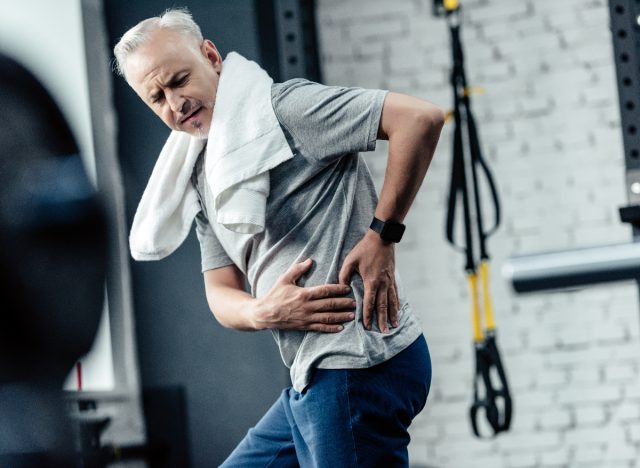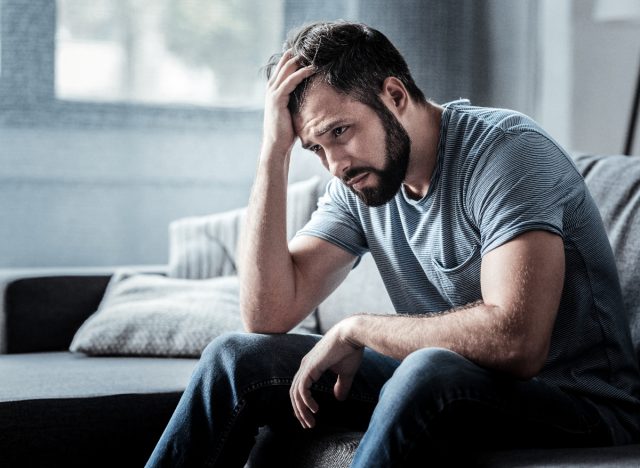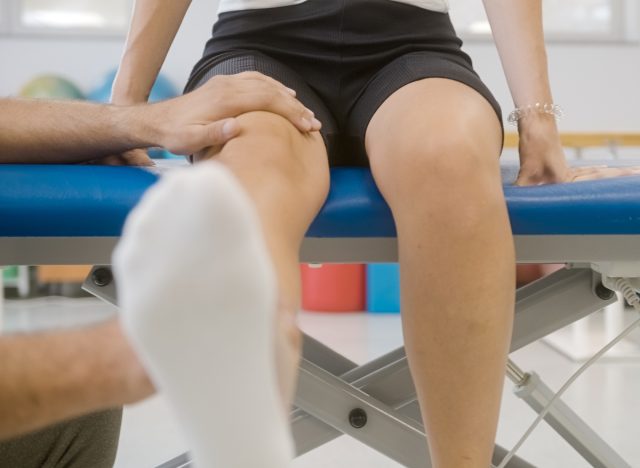Chronic Pain? These Myths Can Prevent You From Recovering

Living with chronic pain is truly one of life’s fun suckers. Pain makes everyday living extremely difficult to focus on anything but the hurt and discomfort you’re experiencing. It also makes it hard to do certain activities you love. In many cases, you may have already seen a medical professional and have whatever treatment is necessary for your particular issue.
We’re here to address how to live with chronic pain, in addition to some popular myths about chronic pain. We have the answers from Abigail Hirsch, PhD, the co-founder and chief product officer at Lin Health, an online platform for chronic pain. Read on to learn more, and next, check out The 6 Best Exercises for Strong and Toned Arms in 2022, Trainer Says.
A little bit about chronic pain

To get a better medical understanding of chronic pain, we spoke with Hirsch, who tells us, “Chronic pain generally describes a situation where pain becomes so frequent that it begins to interfere with people’s lives and their ability to do normal daily activities.” She adds, “Getting an injury is a pretty common part of life, but usually, the pain stops when the injury heals, generally between 3-6 months.”
If you do feel better after that timeframe, you are one of the lucky ones. Unfortunately, for many people (approximately 100 million in the U.S. alone), that’s not the case. For some individuals who endure chronic pain, it can continue much longer, even after the injury itself has healed. According to Hirsch, this happens as a result of changes in the pain signaling system of the brain. She continues to explain that new medical diagnostic guidelines refer to this kind of pain as “chronic primary pain.”
“Some of the most common chronic primary pain presentations include fibromyalgia, lower back pain, neck and shoulder pain, migraines, irritable bowel syndrome, and many arthritic presentations,” Hirsch tells us.
Interestingly, we also learned from Hirsch that the human brain is an excellent learner, but sometimes the brain can become somewhat overenthusiastic and “end up learning to signal pain when it shouldn’t”—it’s a scenario of your brain learning a bad habit. Hirsch does share a bit of optimism, noting, “There’s good news, though; a brain that learns how to make this kind of pain can unlearn it, too.”
Related: Drink This Much Water Each Day To Prevent Heart Failure, New Study Says
It’s all “in your head”

Now that we’ve reviewed the facts, let’s go over some fiction. First off, Hirsch clarifies that one should never believe or be made to believe that feeling pain is just in your head. She warns, “No doctor should ever tell you your pain is ‘in your head,’ as in, it’s not real or something you’ve created. Your pain experience is real.”
It’s a symptom or result of another issue

The next popular myth about chronic pain is that it’s always a result or symptom of another issue. Hirsch is very clear this is false, describing chronic primary pain as “a chronic disease, not a symptom.” She continues, “And it’s highly treatable. It’s important to seek treatment that will support you for the long haul, through the ups and downs, as you get this disorder under control.”
Hirsch suggests if you’ve dealt with or are currently dealing with several pain/discomfort-related experiences such as irritable bowel syndrome, migraines, burning or electric sensations, fatigue, or musculoskeletal pain, it’s more probable that your pain is coming from one primary source. She adds, “It makes much more sense than the idea that your body is continually breaking down with a slew of new issues. Instead of addressing multiple diagnoses, it is worth having a primary pain diagnostic assessment, and find out if a primary pain diagnosis could explain your condition.”
Related: “Unhealthy” Workout Habits To Quit In Your 60s, Trainer Says
There’s no hope

The third very popular chronic pain myth is that there is no hope. This, of course, is totally untrue. Hirsch explains, “There is so much hope, and there’s research to prove it. Primary pain is considered to be a ‘good news’ diagnosis, because it’s highly treatable. Pain retraining techniques are extremely effective.”
Hirsch also presents a recent study from the University of Colorado at Boulder. The study revealed that 98% of the studied subjects who used a new kind of treatment dubbed the “pain reprocessing therapy” improved with their symptoms, and 66% were (or were almost completely) without pain following the treatment.
When it comes to finding the right treatment plan, Hirsch offers caution. “First of all, you should not just be looking to manage pain, and instead really try to focus on pain recovery. Because primary pain is generated by the pain processing system (aka “the brain”), we want to move our focus away from the part of the body that is experiencing the pain and focus on the driver of the pain… the brain,” she says. The positive light at the end of the tunnel is recovery. Hirsch stresses that it is totally possible to recover from chronic pain if you obtain the correct tools to diagnose and treat it properly.
Your body won’t heal from a previous injury

Last but not least is the fallacy that you won’t heal from a previous injury. Hirsch stresses that even though you’re experiencing pain, that doesn’t necessarily mean your tissues are damaged. “Our bodies are incredible at healing from injuries,” she says. “And at the same time, in fact, most persistent pain occurs with minimal or no tissue damage. Primary pain always has a multifactorial, bio-psycho-social etiology.”
How you can effectively treat your chronic pain

Where to begin? Well, Hirsch recommends that a solid place to start is educating yourself on the neuroscience of pain and understanding exactly how the science relates to the specific pain you’re dealing with. She makes one thing clear: “From there, we strongly recommend that you work with a brain-first trained doctor, coach, and/or integrated team so you can begin building an evidence list and learning some new skills.”
Stay optimistic, and know that the right support can lead you through pain reprocessing-based methods in addition to other behavioral health tools, which you’ll be able to incorporate into your daily life.









